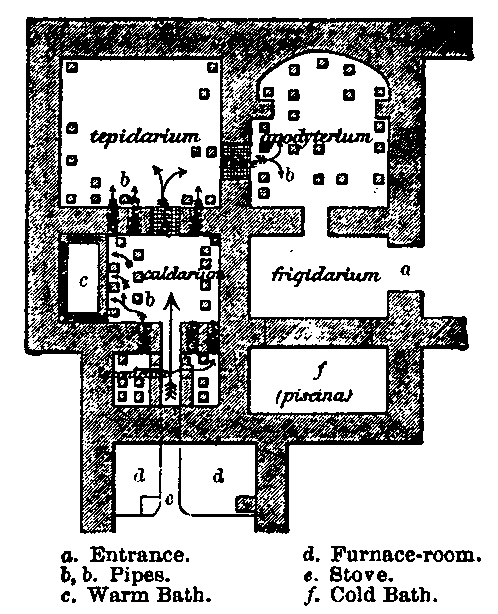|
Dictionary: Search the Dictionary Browse the Dictionary |
|
Timeline: Launch Interactive Timeline |
| Return to Front Page |
| BATHS | |
| Warm baths were for a long time only used by the Greeks for exceptional purposes, to take them too often being regarded as a mark of effeminacy. It was only after the introduction of artificial bathing-places, public and private (balaneia) that they came into fashion, especially before meals. Such baths were often attached to the gymnasia. The Greeks, however, never attained, in this matter, to the luxury of the Romans under the Empire. To take a hot dry air-bath, in order to promote perspiration, followed by a cold bath, was a peculiar fashion of the Lacedaemonians. The ancient custom at Rome was to take a bath every week in the lavatrina or wash-house near the kitchen. But after the Second Punic War bathing establishments on the Greek model made their appearance, and the afternoon hour between two and three was given up to the bath, which, with gymnastics, came to be one of the most important proceedings of the day. The public baths were under the superintendence of the aediles. A small fee (balneaticum) was paid for their use: a quadrans (=about half a farthing) for men, and rather more for women. Children were admitted free. The baths were open from 2 p.m. till sunset; but outside the city precincts they were sometimes lighted up after nightfall. Under the Empire the baths became very luxurious. The splendour of the arrangements, especially in private houses, steadily increased, as did the number of public baths. 170 of these were added by Agrippa alone in his aedileship, and in the 4th century A.D. the number was reckoned at 952 in the city of Rome alone. From the time of Agrippa we find thermae or hot baths, fitted up in the style of those attached to the Greek gymnasia, in use in Rome, Italy, and the provinces. No provincial town was without its baths; indeed they were found in many villages, as is proved by the remains scattered over the whole extent of the Roman empire. The baths of later times consisted of at least three chambers, each with separate compartments for the two sexes. (1) The tepidarium, a room heated with warm air, intended to promote perspiration after undressing; (2) the caldarium, where the hot bath was taken in a tub (solium) or basin (piscina); (3) the frigidarium, where the final cold bath was taken. After this the skin was scraped with a strigilis, rubbed down with a linen cloth, and anointed with oil. This took place either in the tepidarium or in special apartments, which were often provided in larger establishments, as were rooms for dressing and undressing. Round the basin ran a passage, with seats for the visitors. The Laconian or dry airbath was a luxury sometimes, but not necessarily, provided. The heating was managed by means of a great furnace, placed between the men's and the women's baths. Immediately adjoining it were the caldaria, then came the tepidaria and the frigidarium. Over the furnace were fixed a cold-water, warm-water, and hot-water cistern, from which the water was conducted into the bath-rooms. The caldaria and tepidaria were warmed with hot air. The heat was conducted from the furnace into a hollow receptacle under the floor, about two feet in height (suspensura, hypocaustum), and thence by means of flues between the double walls. The Romans were so fond of the bath that if the emperor or a rich citizen presented the people with a free bath for a day, a longer period, or in perpetuity, he won the credit of exceptional liberality. It was not uncommon for a person to leave a sum of money in his will for defraying the costs of bathing. Some towns applied their public funds for this purpose. The accompanying cuts give the ground-plan of the hot baths at Pompeii, and of a private Roman bath found at Caerwent (Venta Silurum) in South Wales. (For a restoration of the Baths of Caracalla, see |
|
|
|
|
| Pictures and Media | |
| ROMAN PRIVATE BATHS, CAERWENT (VENTA SILURUM, MONMOUTHSHIRE). (O. Morgan, Archoelogia, xxvi 2, p. 432, pl. 36.) |

|
|
Copyright 2000-2020 Peter T. Struck. No portion of this site may be copied or reproduced, electronically or otherwise, without the expressed, written consent of the author. |